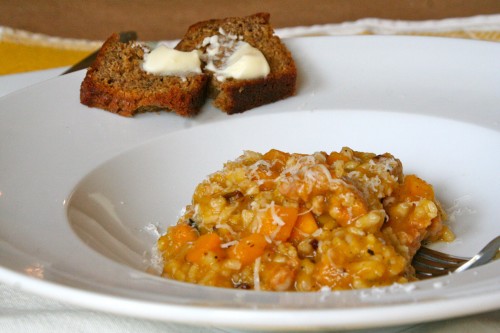 [april]We favor a few good cooking methods that take basic food combinations and turn them into meals in moments: omelettes, pasta, stir fry, soup, and salads. These dishes can elevate even the sorriest of foods from leftovers, too-ripe produce, foods you don’t like that much, and – if you’re refrigerators are not in as desperate state as mine – they’re just great go-to cooking ideas for down right terrific meals made with real food.
[april]We favor a few good cooking methods that take basic food combinations and turn them into meals in moments: omelettes, pasta, stir fry, soup, and salads. These dishes can elevate even the sorriest of foods from leftovers, too-ripe produce, foods you don’t like that much, and – if you’re refrigerators are not in as desperate state as mine – they’re just great go-to cooking ideas for down right terrific meals made with real food.
I’m partial to risotto for the same reason. Risotto takes thirty minutes of easy tending, true it’s longer than zapping frozen sorta-dinners in the microwave, but you get a fresh satisfying one-dish meal out of it.
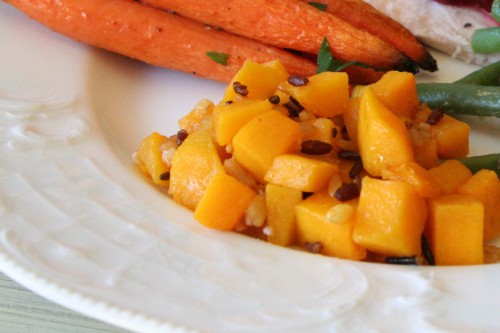 With leftover squash saute´from the big feast and two spicy Italian sausage links (a mistake of fortune made by the butcher at WF who insisted the flame orange links were sweet), a risotto dish blossomed before us. Just a note about kabocha (pronounced ka-boh´cha), it is a Japanese winter squash similar to butternut or acorn squashes, but slightly sweeter and richer.
With leftover squash saute´from the big feast and two spicy Italian sausage links (a mistake of fortune made by the butcher at WF who insisted the flame orange links were sweet), a risotto dish blossomed before us. Just a note about kabocha (pronounced ka-boh´cha), it is a Japanese winter squash similar to butternut or acorn squashes, but slightly sweeter and richer.
Okay folks, I will share my general preparation process for risotto. I will share my exact recipe for this dish. I will share that my stomach is still digesting Thanksgiving dinner. Still, risotto should and could stand improvisation on your part. Look in your refrigerator for inspiration. Find two, maybe three core ingredients that you think will taste great together. They will. recipe and how-tos after the jump
Skip this paragraph if you know your risotto, but Cousin Susie stay put. Risotto is made from arborio rice, a special short grain rice that absorbs liquids well. There are other types of rices used for risotto, but arborio is the the most common and you can find it at your local supermarket. Arborio goes from rice to nice in three simple steps.
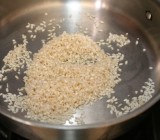
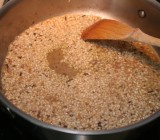
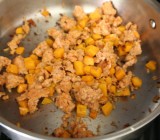 1) Browning rice in heated olive oil seals its outer shell and prevents it from becoming soggy in step 2. 3 minutes
1) Browning rice in heated olive oil seals its outer shell and prevents it from becoming soggy in step 2. 3 minutes
2) Incorporating liquids into the rice, cup by cup. 20-30 minutes
3) Adding core ingredients throughout the cooking time depending on the type of ingredients used.
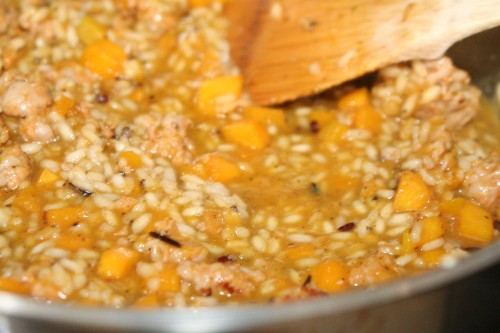 Many succulent Italian risotto dishes use cream for the liquid, but I find that chicken stock, white wine, and pureed soup, are just as good. Our indulgence comes with grated cheese.
Many succulent Italian risotto dishes use cream for the liquid, but I find that chicken stock, white wine, and pureed soup, are just as good. Our indulgence comes with grated cheese.
Also, you will add in the core ingredients depending on the cooking time needed. I browned the sausage and squash before starting the risotto because I didn’t want them to interfere with therisottobrowning, but you can combine this step. I added sausage and squash back in early in the risotto cooking process (step 2) because these were ingredients that wouldn’t overcook. For more delicate ingredients, such as shrimp, seafood and light vegetables, add them in toward the later stages of risotto cooking.
There you have it. One palate pleasing meal emerged, not once, but twice. Risotto can be reheated even though it’s best first time around. To reheat, add your risotto masterpiece to a pan with chicken stock. Heat through, stirring and add more stock until you reach desired consistency.
[recipe]
kabocha squash risotto with spicy sausage
preptime 5 minutes cooktime 20-30 minutes 4 servings
1 T olive oil
1-2 cups cubed cooked kabocha squash
2 spicy Italian chicken sausages
1 cup arborio rice
4 cups chicken stock
1 cup squash soup*
grated hard cheese, parmesan or pecorino
Remove sausage from casing. Heat olive oil in heavy bottom pan on medium to medium low heat. Heat chicken stock in separate pan. Heat the soup in yet another pan. These will be your liquids to add in slowly to the risotto enabling it to absorb the liquids and the flavors. You want them hot so they don’t slow down the cooking process when you add it to the risotto.
Add loose sausage to the pan with olive oil and cook, stirring, for 3 minutes. Add in squash and continue cooking for another 2-3 minutes. Remove from pan while the sausage is still a light pink and set aside.
Pour arborio rice into pan. Stir with attention until the rice begins to lightly brown on all side.
Begin adding chicken stock with just one cup. The rice will sizzle and may incorporate the stock immediately. When the stock is nearly absorbed add another cup of stock. The heat should be on medium. Add the sausage and squash back into the pan. Add 1/3 of the soup. Continue the process – adding a cup of stock until nearly absorbed and then a third of the soup until it’s incorporated and back to the stock and so on – until you reach the desired consistency. The risotto should be creamy within a sauce, but still have some firmness to the bite (al dente).
Top servings with grated cheese and serve.
*I used leftover kabocha squash soup in this recipe. Yes, I love this squash so much I have two leftover dishes made with it. You should have easier options unless you have soup of your own, so I recommend either canned winter squash soup, baby food squash, canned squash puree or the best method is to take or make additional roasted squash and puree it in the blender.
Cook’s Tips: I prefer sausages from Whole Foods’ meat department because they grind the chicken, add seasonings without nitrates and encase the sausages on premise. Broken record here…smell the meat and seafood from WF before you buy it. Because it’s fresh and made without preservatives, the meat and seafood from WF can turn.
Also, for a creamier risotto, grate 1/4 c. parmesan into the risotto pan as a last stage.
Cook’sOptions: Eliminate the soup if you do not have it. Add chopped onion in with arborio rice at the browning stage.
Vegetarian method – eliminate the sausage and use vegetable stock.
recipe provided by your friends at crunchtimefood.com
this post awarded:
Best of the Blogs, by Food News Journal


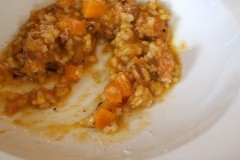
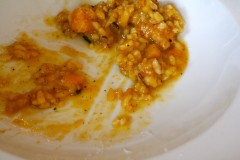
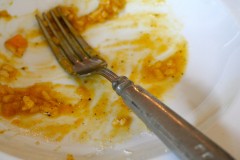
4 Comments
For the novice risotto maker I HIGHLY recommend the Zuni Cafe Cookbook by Judy Rodgers. She gives a several page dissertation on risotto. I have made risotto for years but her techniques brought it to a dish quick enough for weeknights and good enough that my family requests it weekly. In brief she advises to keep the heat high enough that the rice/stock mixture is bubbling. This way the stock is more quickly incorporated (also done quicker) and the resulting “sauce” is super creamy.
Leave a Reply